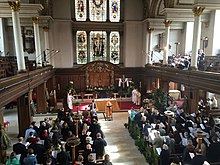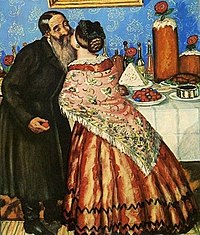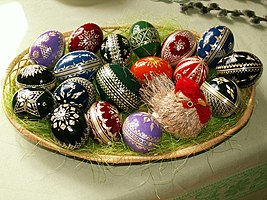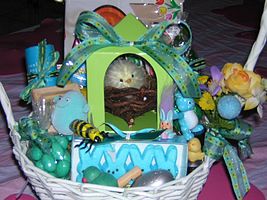Easter 2
Eastern Christianity
In Eastern Christianity, the spiritual preparation for Easter/Pascha begins with Great Lent, which starts on Clean Monday and lasts for 40 continuous days (including Sundays). Great Lent ends on a Friday, and the next day is Lazarus Saturday. The Vespers which begins Lazarus Saturday officially brings Great Lent to a close, although the fast continues through the following week.[113][114]
The Paschal Vigil begins with the Midnight Office, which is the last service of the Lenten Triodion and is timed so that it ends a little before midnight on Holy Saturday night. At the stroke of midnight the Paschal celebration itself begins, consisting of Paschal Matins, Paschal Hours, and Paschal Divine Liturgy.[115]
The liturgical season from Easter to the Sunday of All Saints (the Sunday after Pentecost) is known as the Pentecostarion (the "50 days"). The week which begins on Easter Sunday is called Bright Week, during which there is no fasting, even on Wednesday and Friday. The Afterfeast of Easter lasts 39 days, with its Apodosis (leave-taking) on the day before the Feast of the Ascension. Pentecost Sunday is the 50th day from Easter (counted inclusively).[116] In the Pentecostarion published by Apostoliki Diakonia of the Church of Greece, the Great Feast Pentecost is noted in the synaxarion portion of Matins to be the 8th Sunday of Pascha. However, the Paschal greeting of "Christ is risen!" is no longer exchanged among the faithful after the Apodosis of Pascha.[117][118]
Liturgical observance
 Christian worshippers attend an Easter Sunday church service at St James's Church in London. The cross in the chancel is draped with a white shroud, symbolizing the resurrection.[119][120]
Christian worshippers attend an Easter Sunday church service at St James's Church in London. The cross in the chancel is draped with a white shroud, symbolizing the resurrection.[119][120]
Western Christianity
The Easter festival is kept in many different ways among Western Christians. The traditional, liturgical observation of Easter, as practised among Roman Catholics, Lutherans,[121] and some Anglicans begins on the night of Holy Saturday with the Easter Vigil which follows an ancient liturgy involving symbols of light, candles and water and numerous readings form the Old and New Testament.[122]
Services continue on Easter Sunday and in a number of countries on Easter Monday. In parishes of the Moravian Church, as well as some other denominations such as the Methodist Churches, there is a tradition of Easter Sunrise Services[123] often starting in cemeteries[124] in remembrance of the biblical narrative in the Gospels, or other places in the open where the sunrise is visible.[125]
In some traditions, Easter services typically begin with the Paschal greeting: "Christ is risen!" The response is: "He is risen indeed. Alleluia!"[126]
Eastern Christianity
 The congregation lighting their candles from the new flame, just as the priest has retrieved it from the altar. The picture is flash-illuminated; all electric lighting is off, and only the oil lamps in front of the Iconostasis remain lit. (St. George Greek Orthodox Church, Adelaide).
The congregation lighting their candles from the new flame, just as the priest has retrieved it from the altar. The picture is flash-illuminated; all electric lighting is off, and only the oil lamps in front of the Iconostasis remain lit. (St. George Greek Orthodox Church, Adelaide).
Eastern Orthodox, Eastern Catholics and Byzantine Rite Lutherans have a similar emphasis on Easter in their calendars, and many of their liturgical customs are very similar.[127]
Preparation for Easter begins with the season of Great Lent, which begins on Clean Monday.[128] While the end of Lent is Lazarus Saturday, fasting does not end until Easter Sunday.[129] The Orthodox service begins late Saturday evening, observing the Jewish tradition that evening is the start of liturgical holy days.[129]
The church is darkened, then the priest lights a candle at midnight, representing the resurrection of Jesus Christ. Altar servers light additional candles, with a procession which moves three times around the church to represent the three days in the tomb.[129] The service continues early into Sunday morning, with a feast to end the fasting. An additional service is held later that day on Easter Sunday.[129]
Non-observing Christian groups
Many Puritans saw traditional feasts of the established Anglican Church, such as All Saints' Day and Easter, as abominations because the Bible does not mention them.[130][131] Conservative Reformed denominations such as the Free Presbyterian Church of Scotland and the Reformed Presbyterian Church of North America likewise reject the celebration of Easter as a violation of the regulative principle of worship and what they see as its non-Scriptural origin.[132][133]
Members of the Religious Society of Friends (Quakers), as part of their historic testimony against times and seasons, do not celebrate or observe Easter or any traditional feast days of the established Church, believing instead that "every day is the Lord's Day," and that elevation of one day above others suggests that it is acceptable to do un-Christian acts on other days.[134][135] During the 17th and 18th centuries, Quakers were persecuted for this non-observance of Holy Days.[136]
Groups such as the Restored Church of God reject the celebration of Easter, seeing it as originating in a pagan spring festival adopted by the Roman Catholic Church.[137][138][139]
Jehovah's Witnesses maintain a similar view, observing a yearly commemorative service of the Last Supper and the subsequent execution of Christ on the evening of Nisan 14 (as they calculate the dates derived from the lunar Hebrew calendar). It is commonly referred to by many Witnesses as simply "The Memorial". Jehovah's Witnesses believe that such verses as Luke 22:19–20 and 1 Corinthians 11:26 constitute a commandment to remember the death of Christ though not the resurrection.[140][141]
Easter celebrations around the world
Main article: Easter traditions
In countries where Christianity is a state religion, or those with large Christian populations, Easter is often a public holiday.[142] As Easter always falls on a Sunday, many countries in the world also recognize Easter Monday as a public holiday.[143] Some retail stores, shopping malls, and restaurants are closed on Easter Sunday. Good Friday, which occurs two days before Easter Sunday, is also a public holiday in many countries, as well as in 12 U.S. states. Even in states where Good Friday is not a holiday, many financial institutions, stock markets, and public schools are closed – the few banks that are normally open on regular Sundays are closed on Easter.[144] Boris Kustodiev's Pascha Greetings (1912) shows traditional Russian khristosovanie (exchanging a triple kiss), with such foods as red eggs, kulich and paskha in the background.
Boris Kustodiev's Pascha Greetings (1912) shows traditional Russian khristosovanie (exchanging a triple kiss), with such foods as red eggs, kulich and paskha in the background.
In the Nordic countries Good Friday, Easter Sunday, and Easter Monday are public holidays,[145] and Good Friday and Easter Monday are bank holidays.[146] In Denmark, Iceland and Norway Maundy Thursday is also a public holiday. It is a holiday for most workers, except those operating some shopping malls which keep open for a half-day. Many businesses give their employees almost a week off, called Easter break.[147] Schools are closed between Palm Sunday and Easter Monday. According to a 2014 poll, 6 of 10 Norwegians travel during Easter, often to a countryside cottage; 3 of 10 said their typical Easter included skiing.[148]
In the Netherlands both Easter Sunday and Easter Monday are national holidays. Like first and second Christmas Day, they are both considered Sundays, which results in a first and a second Easter Sunday, after which the week continues to a Tuesday.[149]
In Greece Good Friday and Saturday as well as Easter Sunday and Monday are traditionally observed public holidays. It is custom for employees of the public sector to receive Easter bonuses as a gift from the state.[150]
In Commonwealth nations Easter Day is rarely a public holiday, as is the case for celebrations which fall on a Sunday. In the United Kingdom both Good Friday and Easter Monday are bank holidays, except for Scotland, where only Good Friday is a bank holiday.[151] In Canada, Easter Monday is a statutory holiday for federal employees. In the Canadian province of Quebec, either Good Friday or Easter Monday are statutory holidays (although most companies give both).[152]
In Australia, Easter is associated with harvest time.[153] Good Friday and Easter Monday are public holidays across all states and territories. "Easter Saturday" (the Saturday before Easter Sunday) is a public holiday in every state except Tasmania and Western Australia, while Easter Sunday itself is a public holiday only in New South Wales. Easter Tuesday is additionally a conditional public holiday in Tasmania, varying between award, and was also a public holiday in Victoria until 1994.[154]
In the United States, because Easter falls on a Sunday, which is already a non-working day for federal and state employees, it has not been designated as a federal or state holiday.[155] Easter parades are held in many American cities, involving festive strolling processions.[30]
Easter eggs
Main article: Easter egg
See also: Easter food
Traditional customs
The egg is an ancient symbol of new life and rebirth.[156] In Christianity it became associated with Jesus's crucifixion and resurrection.[157] The custom of the Easter egg originated in the early Christian community of Mesopotamia, who stained eggs red in memory of the blood of Christ, shed at his crucifixion.[158][159] As such, for Christians, the Easter egg is a symbol of the empty tomb.[25][26] The oldest tradition is to use dyed chicken eggs.
In the Eastern Orthodox Church Easter eggs are blessed by a priest[160] both in families' baskets together with other foods forbidden during Great Lent and alone for distribution or in church or elsewhere.

- Traditional red Easter eggs for blessing by a priest
-

- A priest blessing baskets with Easter eggs and other foods forbidden during Great Lent
-

- A priest distributing blessed Easter eggs after blessing the Soyuz rocket
Easter eggs are a widely popular symbol of new life among the Eastern Orthodox but also in folk traditions in Slavic countries and elsewhere. A batik-like decorating process known as pisanka produces intricate, brilliantly colored eggs. The celebrated House of Fabergé workshops created exquisite jewelled Easter eggs for the Russian Imperial family from 1885 to 1916.[161]
Modern customs
A modern custom in the Western world is to substitute decorated chocolate, or plastic eggs filled with candy such as jellybeans; as many people give up sweets as their Lenten sacrifice, individuals enjoy them at Easter after having abstained from them during the preceding forty days of Lent.[162]

- Easter eggs, a symbol of the empty tomb, are a popular cultural symbol of Easter.[24]
-
- Marshmallow rabbits, candy eggs and other treats in an Easter basket
-

- An Easter egg decorated with the Easter Bunny
Manufacturing their first Easter egg in 1875, British chocolate company Cadbury sponsors the annual Easter egg hunt which takes place in over 250 National Trust locations in the United Kingdom.[163][164] On Easter Monday, the President of the United States holds an annual Easter egg roll on the White House lawn for young children.[165]
Easter Bunny
Main article: Easter Bunny
In some traditions, the children put out their empty baskets for the Easter bunny to fill while they sleep. They wake to find their baskets filled with candy eggs and other treats.[166][31] A custom originating in Germany,[166] the Easter Bunny is a popular legendary anthropomorphic Easter gift-giving character analogous to Santa Claus in American culture. Many children around the world follow the tradition of coloring hard-boiled eggs and giving baskets of candy.[31] Historically, foxes, cranes and storks were also sometimes named as the mystical creatures.[166] Since the rabbit is a pest in Australia, the Easter Bilby is available as an alternative.[167]
Music
 This section needs expansion. You can help by adding to it. (March 2021)
This section needs expansion. You can help by adding to it. (March 2021) This section needs additional citations for verification. Please help improve this article by adding citations to reliable sources in this section. Unsourced material may be challenged and removed. (April 2023) (Learn how and when to remove this template message)
This section needs additional citations for verification. Please help improve this article by adding citations to reliable sources in this section. Unsourced material may be challenged and removed. (April 2023) (Learn how and when to remove this template message) This article may need to be rewritten to comply with Wikipedia's quality standards. You can help. The talk page may contain suggestions. (April 2023)
This article may need to be rewritten to comply with Wikipedia's quality standards. You can help. The talk page may contain suggestions. (April 2023)
- Marc-Antoine Charpentier:[168][169]
- Messe pour le samedi de Pâques, for soloists, chorus and continuo, H.8 (1690).
- Prose pour le jour de Pâques, for 3 voices and continuo, H.13 (1670)
- Chant joyeux du temps de Pâques, for soloists, chorus, 2 treble viols, and continuo, H.339 (1685).
- O filii à 3 voix pareilles, for 3 voices, 2 flutes, and continuo, H.312 (1670).
- Pour Pâques, for 2 voices, 2 flutes, and continuo, H.308 (1670).
- O filii pour les voix, violons, flûtes et orgue, for soloists, chorus, flutes, strings, and continuo, H.356 (1685?).
- Louis-Nicolas Clérambault: Motet pour le Saint jour de Pâques, in F major, opus 73
- André Campra: Au Christ triomphant, cantata for Easter
- Dieterich Buxtehude: Cantatas BuxWV 15 and BuxWV 62
- Carl Heinrich Graun: Easter Oratorio
- Henrich Biber: Missa Christi resurgentis C.3 (1674)
- Michael Praetorius: Easter Mass
- Johann Sebastian Bach: Christ lag in Todesbanden, BWV 4; Der Himmel lacht! Die Erde jubilieret, BWV 31; Oster-Oratorium, BWV 249.
- Georg Philipp Telemann: more than 100 cantatas for Eastertide.
- Jacques-Nicolas Lemmens: Sonata n° 2 "O Filii", Sonata n° 3 "Pascale", for organ.
- Charles Gounod: Messe solennelle de Pâques (1883).
- Nikolai Rimsky-Korsakov: La Grande Pâque russe, symphonic overture (1888).
- Sergueï Vassilievitch Rachmaninov: Suite pour deux pianos n°1 – Pâques, op. 5, n° 4 (1893).
See also
 Christianity portal
Christianity portal Holidays portal
Holidays portal- Divine Mercy Sunday
- Life of Jesus in the New Testament
- List of Easter films
- List of Easter hymns
- List of Easter television episodes
- Movable Eastern Christian Observances
- Regina Caeli
- Category:Film portrayals of Jesus' death and resurrection
Footnotes
- ^ Traditional names for the feast in English are "Easter Day", as in the Book of Common Prayer; "Easter Sunday", used by James Ussher (The Whole Works of the Most Rev. James Ussher, Volume 4[1]) and Samuel Pepys (The Diary of Samuel Pepys, Volume 2[2]), as well as the single word "Easter" in books printed in 1575,[3] 1584,[4] and 1586.[5]
- ^ In the Eastern Orthodox Church, the Greek word Pascha is used for the celebration; in English, the analogous word is Pasch.[6][7]
- ^ The term "Resurrection Sunday" is used particularly by Christian communities in the Middle East.[8][9]
- ^ Old English pronunciation: [ˈæːɑstre, ˈeːostre]
- ^ Eusebius reports that Dionysius, Bishop of Alexandria, proposed an 8-year Easter cycle, and quotes a letter from Anatolius, Bishop of Laodicea, that refers to a 19-year cycle.[80] An 8-year cycle has been found inscribed on a statue unearthed in Rome in the 17th century, and since dated to the 3rd century.[81]



































































